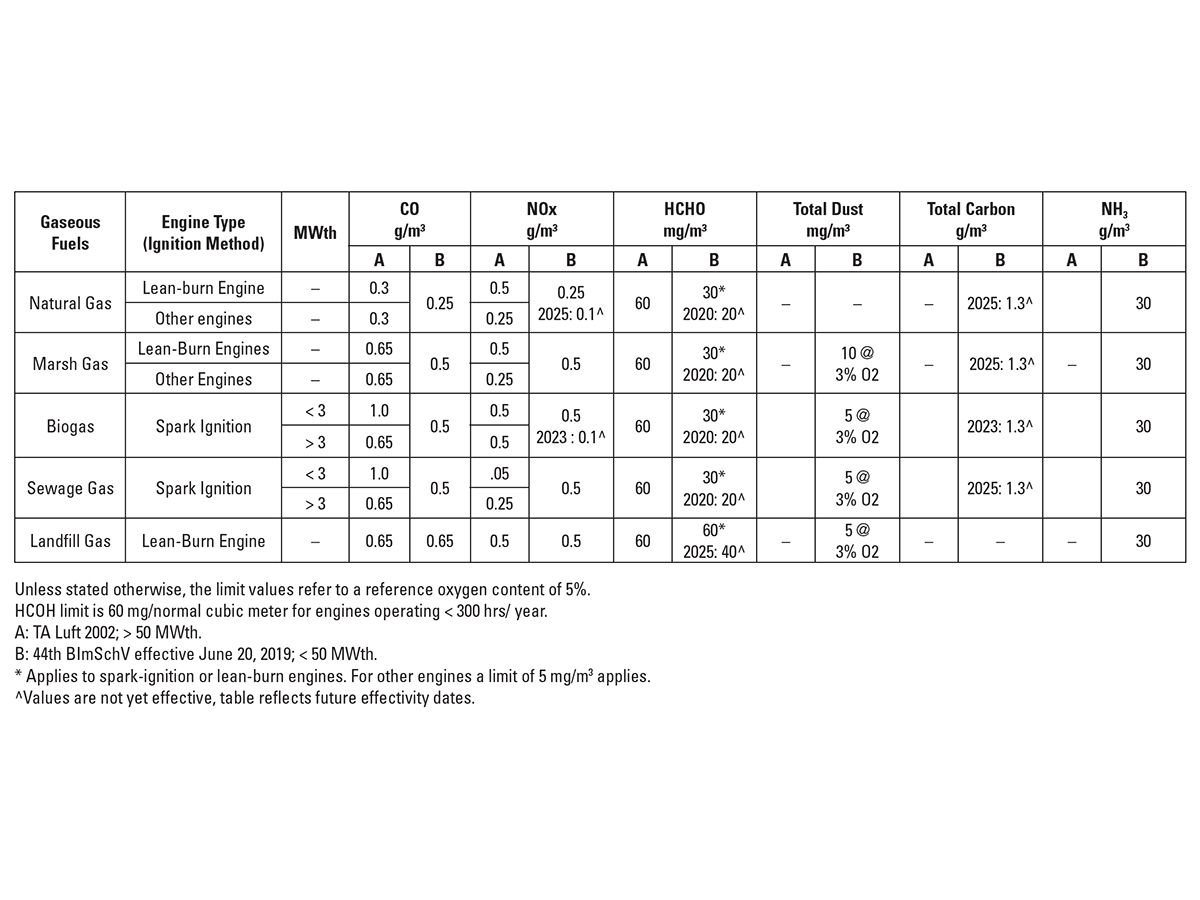REDUCTION OF NITROGEN OXIDES BY MEANS OF SCR CATALYST
With the help of selective catalytic reduction (SCR) technology, used in CHP plants for decades, nitrogen oxides can be reliably reduced to levels below 100 mg/mn3. An aqueous urea solution (called AdBlue in the automotive industry) is injected into the exhaust gas downstream of the engine and upstream of the catalytic converter. Mixers create a uniform distribution of the urea in the exhaust gas. Thermolysis and hydrolysis in the exhaust gas produce ammonia (NH3) and carbon dioxide (CO2) from the aqueous urea solution. The ammonia in turn causes a reduction in NOx in the catalyst, so that nitrogen gas and water are formed.
Depending on the dimensions of the catalyst and the amount of urea injected, NOx emissions can be reduced by up to 95%. The amount of urea solution that needs to be injected depends on the level of NOx in the exhaust gas. In a controlled SCR catalytic converter (Figure 2), the NOx content in the exhaust gas is measured and the urea dosage is adjusted via the metering pump. Since engines manufactured by Caterpillar Energy Solutions GmbH are equipped with a combustion chamber temperature control that regulates NOx to a constant value, these gas engines can be equipped with a controlled SCR catalyst. This eliminates the emission measurement. Since the amount of NOx in the exhaust gas depends on the momentary power of the engine, the amount of injected urea is regulated on that basis. This design is simpler and less expensive and also achieves the required emission reduction. For better distribution of the urea, air is blown in at the same time the urea is injected. After the SCR catalyst is switched off, the shutdown of the air is delayed long enough to clean the nozzle of urea residues. This prevents the nozzle from clogging over time.
Formaldehyde reduction is also achieved by an SCR system, although the mechanisms of action have not yet been sufficiently researched. The FVV (Research Association for Combustion Engines) has started a research project looking at this question. SCR technology can be used with fuels including pipeline natural gas, biogas, sewage gas and coal mine gas without any problems. In greenhouses in the Netherlands, this technology is part of the engine system and enables the cleaned exhaust gases to be blown into the greenhouses for CO2 fertilization. A limit value of 100 mg/mn3, as the 44th BImSchV is expected to include, has been proven safe for such applications. In addition, SCR technology offers the possibility of operating the engines with a richer air/fuel mixture and thus with higher effi ciencies, more than compensating for the cost of urea.
At the same time, engine raw emissions of formaldehyde and THC, which consists essentially of methane, are reduced by up to 20 percent, depending on engine size. The technology also provides an advantage in terms of wear on components including spark plugs and valves. Therefore it can be said that SCR technology for gas engines has matured and can make a contribution to environmental protection while enabling economical plant operation. Although in the first step the BImSchV for NOx specifies 250 mg/mn3 as the limit, analogous to the MCPD, SCR technology should be used to reach this limit, since otherwise THC values increase significantly (Figure 3).
RETROFITTING SCR TECHNOLOGY FOR EXISTING SYSTEMS
Until now, the new limit values in TA-Luft were transferred to existing plants after a transitional period, as the European MCPD and the new BImSchV also provide. Concerns were expressed that retrofitting SCR catalytic converters was not possible for reasons of space alone. The CHP plants installed in Germany with more than 1 MW of rated thermal input are individually designed according to the customer’s wishes, so that there are no standard solutions for retrofitting. Therefore, engineering assistance is required. Local conditions need to be analyzed and suitable systems designed accordingly. In most cases, this is feasible.
For example, Caterpillar Energy Solutions GmbH retrofitted an SCR system on a CHP installation at an existing wastewater treatment plant with an electrical output of 1 MWe. Here, the task was to reduce the exhaust emissions without having a negative effect on the other properties of the CHP plant, especially with respect to sound emissions. The CHP system is constructed in a container similar that shown in Figure 4, with limited space. To make room, the muffler combination, consisting of a reflection and an absorption part, was removed from the container roof. Although the SCR catalyst also has a sound insulating effect at higher frequencies, it cannot by itself compensate for the effect of the remote muffler combination. Therefore, a new reflection attenuator was designed using the free space on the container roof so that the original sound reduction was maintained. Figure 5 shows the comparison of the sound values before and after the conversion. The sound spectra are identical within the range of measurement accuracy.
The plant’s SCR catalyst also achieves the exhaust emission limits expected under the new regulations. The amount of urea was adjusted so that NOx emissions are below 100 mg/mn3. Then the CO value was set to 100 mg/mn3 and formaldehyde to 20 mg/mn3, which means a reduction of NOx emissions by 80 (Figure 6). The complete system has been in use for several thousand hours with extremely low variation in emissions. It must be noted that siloxane contamination of the sewage gas affects the aging of the SCR catalyst. Although activated carbon treatment substantially reduces siloxanes in the gas stream, very small amounts are still present in the fuel gas.
REDUCTION OF FORMALDEHYDE AND CARBON MONOXIDE USING AN OXIDATION CATALYST
Formaldehyde is another emission that engineers have been very successful in reducing. According to EU guideline CLP (EU Regulation No. 1272/2008), formaldehyde was classified as a carcinogen, whereupon the limit values for that pollutant were lowered from the levels established in 2016, based on the recommendation of the LAI (Federal/Länder Association for Pollution Control) and adopted in the new BImSchV.
Formaldehyde is formed as an intermediate product during the combustion of methane. While most of the formaldehyde is ultimately burned, some can persist in dead spaces in the engine combustion chamber, in particular due to relatively low cylinder wall temperatures. With improvements in combustion chamber design, these dead spaces can be significantly reduced, in turn generating lower formaldehyde emissions. At the same time, oxidation catalysts have been further developed to enhance their formaldehyde conversion rate and service life. The overall system, engine and catalytic converter, has been optimized so that the projected formaldehyde emission limit of 20 mg/mn3 can be reliably maintained during operation. In combination with SCR technology, these low emissions stabilize even further. Thus, here too, the future emission limits are easily complied with.
The basis of the design of oxidation catalysts by necessity is reduction of formaldehyde, as that determines the size and coating of the catalyst. This then also yields the necessary level of reduction of CO emissions, which remains almost constant at levels not exceeding 100 mg/nm3 during the expected catalyst life of two years of continuous operation.
When an oxidation catalyst is placed downstream of an SCR catalyst, its further task is to oxidize breakthrough ammonia to NOx and water. Care must be taken here to keep the amounts of ammonia as low as possible so that the NOx emissions do not increase again. Practice has shown that by properly sizing the SCR catalyst and the quantity of urea injected, the amount of ammonia breakthrough is small. The projected limit of 30 mg/mn3 must be adhered to.
THC EMISSIONS
The problem child in engine exhaust emissions is THC, consisting substantially of methane. THC represents methane that has passed through the combustion process unburned and into the exhaust gas flow. This is a thorn in the side of development engineers, because ideally this methane should burn in the combustion chamber, further increasing efficiency. This “methane slip” has been reduced by modifications to combustion chamber geometry so that the limit value of 1300 mg/mn3 can be maintained. However, from an environmental perspective, this is not good enough, as the greenhouse gas potential of methane is about 23 times that of CO2. Therefore, intensive research on methane catalysts is being conducted. Caterpillar Energy Solutions GmbH participates intensively in various research projects with the FVV (Research Association for Combustion Engines) and the DBFZ (German Biomass Research Center). Material combinations able to reduce methane have been found, but in practical plant operation the conversion rate decreased so much within a few days that the catalyst was not useful for plant operation. This area needs further research.
SUMMARY AND OUTLOOK
Gas engines, when used in CHP plants to produce electricity and heat, generate energy with the least possible impact on the environment. The engines can comply with the stricter limit values for exhaust emissions laid down in the 44th BImSchV and the new TA-Luft. In addition, current research and development work has the potential to further reduce exhaust emissions from these engines. For the time being, Caterpillar Energy Solutions GmbH offers gas engines and exhaust aftertreatment systems for the various CHP applications that comply with the statutory emission requirements.














